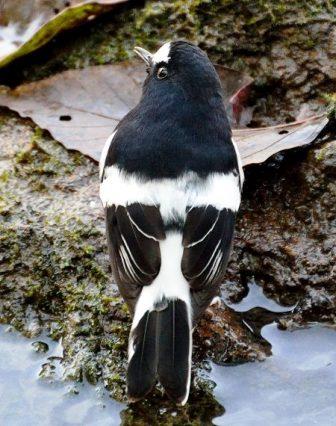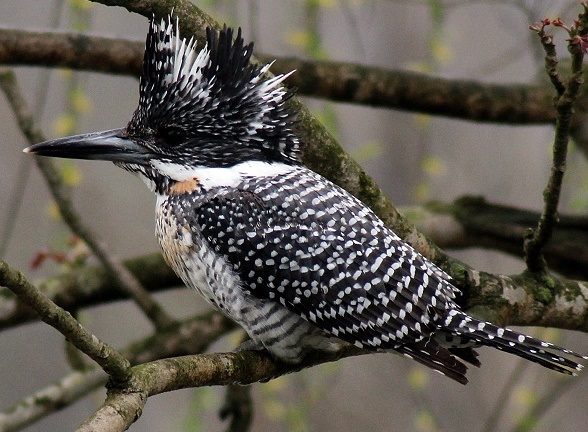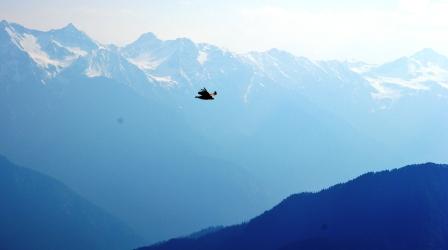Biodiversity / Animal
Birds
The birds of GHNP are an important part of the Park’s biological diversity, in their own right and as indicators of diversity within the wider ecosystem. They are also an attraction for bird watchers at an international level. The Park is well known as the most important locality in India for the endangered Western Tragopan. Four other species of pheasant occur in or adjacent to the Park; the one most likely to be seen by visitors is the Monal, an abundant bird in the higher forests, although rather shy. Raptors are also a prominent feature of the Park, with Lammergeiers, Himalayan Griffon Vultures and Golden Eagles being seen regularly. A great variety of other birds occurs (a total of 209 species), some of which reach their western limit in the Park.

symbol of the Great Himalayan National Park
The GHNP falls within one of the more than 200 globally important Endemic Bird Areas (D02: Western Himalaya) identified by the International Committee for Bird Protection (ICBP) Biodiversity Project (ICBP 1992 and known as EBA 128 in more recent updates). ICBP, now BirdLife International, is one of the world’s most respected and influential proponents of avian species and habitat conservation, and official Red List Authority for birds for the International Union for the Conservation of Nature’s (IUCN) Red Data Book of Threatened Species. The World Wide Fund for Nature (WWF) has listed, since 2001, parts of the Himalaya in its Global 200 analysis of critical ecosystems, in part due to the significance of and threats to the region’s avian fauna. More recent WWF work has developed many finer-scaled terrestrial ecoregions into which GHNP clearly fits. WWF, BI, IUCN and other relevant overseers of the status of Threatened bird species continually stress the importance of effective management of protected areas in the Himalayan region, including GHNP.
Important Bird Groups
Within the Great Himalayan National Park, birds such as Long-tailed Minivets, Yellow-bellied Fantails, Wallcreepers, White-collared and Grey-winged blackbirds become common at the lowest altitudes in winters. Heavy snow may bring down more exotic species, such as variegated laughing thrush, Scaly-breasted Wren Babbler, Spectacled Finch and Golden Bush Robin, all of which may occur from October to February in the lower parts of the main valleys of the Park. In addition, there are a few species of longer distance migrants that winter preferentially in the Park: Blue-capped Redstart, Black-throated Thrush and Black-throated Accentor.

The streams and rivers in Himalayas support a very distinctive bird community, one that is more diverse than can be found in any other mountain range on earth. The most obvious birds are the White-capped and Plumbeous Water Redstarts, and Forktails which are common in summer along streams at all altitudes up to about 4000 m. The White-capped Water Redstart is especially fond of the small, rapid streams feeding the watermills that are a common feature of valleys adjacent to the Park. The Brown Dipper, less obvious than the water redstarts, but no less widespread, makes its presence known by its characteristic call, as it buzzes along the river, before diving under the water to pluck insects from among stones and rocks on the river bed. Less abundant, and usually found along small, wooded streams are the Little and Spotted Forktails – the latter a spectacular sight with its long, scissor-like, black-and-white tail. The Grey Wagtail does not reside in the Park, but is a common winter visitor to streams at lower altitudes.


The lower forest zone in the Park has characteristic birds including the Black-crowned and Himalayan jays, the Yellow-billed Magpie, the Greyheaded and Black-crowned flycatcher-warblers, and the Bar-tailed Treecreeper, as well as several species of leaf warblers and tits, and a number of small babblers: the Black-chinned Babbler, White-browed and Green shrike babblers, Chestnut-tailed Minla, Rufous Sibia, and Whiskered Yuhina. In summer, several species of flycatchers also occur, including the well-named Beautiful Niltava and the subtly-coloured Verditer Flycatcher. The higher altitude forests are inhabited in summer by a very distinctive avifauna including Orange-flanked Bush Robin, Ashy-throated, Pale-rumped and Buff-barred leaf warblers, Grey-crested, Dark Grey, Yellow-browed and Rufous-vented tits (the latter rare), the White-throated Tit, the Goldcrest and the White-cheeked Nuthach. The warblers are found lower down in winter, but the tits and Goldcrest remain in these high forests even under heavy snow.
Golden Eagles, Lammergeyers, and Himalayan Griffon Vultures are all common in the sub-alpine zone, while Blue-fronted Redstart, Scaly-breasted Wren-babbler, White-browed Fulvetta and elements of the upper forest zone community inhabit the scrub, augmented in autumn by large flocks of Rufous-streaked Accentors and Plain Mountain Finches. On the highest meadows, the fortunate may find Snow Partridge, Grandala or, where marshy, the Solitary Snipe, but none of these is common.
The true alpine zone, although rich in flowering plants, does not support a large diversity of birds, but Rufous-breasted Accentor, Himalayan Snowcock and Dark-breasted Rosefinch all occur. Parts of the interior areas of the Park, especially the upper part of the Parbati Valley support ecology similar to that of the trans-Himalayan zone. Mistle Thrush, Black Redstart, Winter Wren, Fire-fronted Serin, Rock Bunting and Red-billed Chough are common in these areas.
Five Pheasants
Pheasants are an important group of large, spectacular birds. GHNP holds the largest number of known populations of Western Tragopan in the world (also found in the newly created Khirganga National Park on the north side of the GHNP). Another threatened pheasant, the Cheer Pheasant, is present on the steep, south-facing grassy slopes. Monal and Koklass are abundant in the temperate forest zone, while Kaleej occurs in small numbers below 2,000 m. Snow Partridge, Hill Partridge and Himalayan Snowcock also occur. The upper part of the forest zone is the haunt of the Great Himalayan National Park’s most famous birds, the Monal, Koklass and Western Tragopan pheasants. The area contains an important concentration of the Western Tragopan, which prefers areas of ringal bamboo under dense forest. The Great Himalayan National Park is probably the best place in India to observe this species in its natural habitat and it is the only place in the world where a detailed ecological study on the pheasant has been undertaken, involving radio-telemetry.
- Western Tragopan Tragopan melanocephalus is a medium sized brightly plumaged bird with males and females weighing 1,800-2,200 g and 1300-1400 g respectively. Male possesses a red-tipped long crest, feathered with reddish back, and the sides of the neck and face are red. The upper parts are covered with buffish grey and black with prominent white spots. Crest feathers are absent in females and they lack the red colour excepting on the face and legs, which are pinkish. Females have pale brownish grey upper parts finely vermiculated and spotted with black, and most of the feathers have black patches and central white streaks.Western Tragopan, also known as Western Horned Tragopan, is considered among the rarest of all living pheasants. This Threatened (status vulnerable) pheasant is endemic to the northwest Himalaya with a narrow range from Hazara in north Pakistan through Jammu & Kashmir, Himachal Pradesh to the western part of Garhwal in India. Due to its beautiful plumage and large size, this bird is locally called “Jujurana”, which means “King of Birds”. It is reported to inhabit upper temperate forests between 2,400 and 3,600 m in summer, and in winter, dense coniferous and broad leave forests between 2,000 and 2,800 m elevations. They mostly feed on leaves, shoots, and seeds, but also consume insects and other invertebrates. Like most pheasants, they roost on trees singly or in pairs except during nesting, which is reported to be on the ground or in trees.

Western Tragopan Male The population of Western Tragopan is threatened by several anthropogenic factors throughout its range.The declining world population of this species has been estimated at 1,600 to 4,800 (Gaston et al. 1983), including the captive population that currently numbers less than 25 birds. CITES has listed this species in Appendix I in order to discourage selling of its feathers. Representing the endemic bird area D02 (Western Himalaya), Western Tragopan has been described as a range-restricted species (ICBP 1992).

Western Tragopan Display - Monal Pheasant The Monal Pheasant is a relatively large pheasant. Males and females weigh about 1,980-2,380 g and 1,800-2,150 g respectively. An adult male possess a long crest, and is feathered with multicoloured plumage throughout its body, while the females, like in other pheasants, are dull in colour with the upper parts covered with dark brownish-black feathers. Notable features in males are a long crest that is metallic green, changeable reddish copper on the back and sides of the neck and, a prominent white back and rump while in flight. Tail feathers of the males are uniformly rufous, being darker towards the tips, where as the lower tail coverts of females are white, barred with black and rufous. Females have a prominent white patch on the foreneck and a white strip on the tail.First-year and immature males resemble females, but first-year males are larger and the immature are less distinctly marked.The Monal secures a distinct position among pheasants due to its prominent build, brilliant plumage and strong association with local folklore.

Monal Male It occupies upper temperate oak-conifer forests interspersed with open grassy slopes, cliffs and alpine meadows between 2,400 and 4,500 m, mostly concentrating in a narrow belt of 2,700-3,700 m. They seem to exhibit clear and fluctuating altitudinal migration reaching as low as 2,000 m in winter. However, they show tolerance to snow and have been observed to dig through it for roots, tubers and other plant parts, and invertebrates. Seen in pairs during the breeding season (April to August), they form large coveys and participate in communal roosting during the winter. The population of this species in most of its range is threatened by poaching and other anthropogenic factors. The male monal had been under heavy hunting pressure for its crest feather, which as described above was used to ornament hats of Himachal men, until 1982, when legal hunting was banned in the state.
- Koklass The Koklass is a medium-sized, elusive bird confined to high altitude forests from Afghanistan to central Nepal, and in north-eastern Tibet to northern and eastern China. The upper parts of the male Koklass are covered with silver-grey plumage streaked velvety-black down the center of each feather, and it has the unique feature of a black head, chestnut breast and prominent white patches on the sides of neck.The females differ from males in the above characteristics; instead, their upper parts are covered with pale brown plumage. Both sexes, however, have distinct elongated tails tipped with pale feathers. The males are known to weigh about 1,135-1,415 g, and the females about 1,025-1,135 g, with the body length varying from 58 to 64 cm and 18-22 cm respectively.

Koklash Pheasant (Male) Immature and juveniles resemble adult females in plumage pattern. Like the Western Tragopan, the Koklass does not extend its range above the tree line. One of the less colourful pheasants, the Koklass exhibits moderate sexual dimorphism. Though they skulk under bushes, which makes direct sighting difficult, they give loud chorus/predawn calls during the breeding season and during autumn, revealing their presence. They remain in pairs or small family groups throughout the year. Nest on the ground and spend the nights roosting on trees, or under rock overhangs.
- White-crested KaleejA rather chicken-like, black and white pheasant with a red face and white crest; female all brown except for red face patch. Kaleej live in thickets of bamboo, and shrubs adjacent to cultivation and water sources. They also dwell in pure Ban Oak forest as well as mixed forest of cedar, Blue Pine and Kharsu Oak. Most of the roosting sites were observed in Ban Oak forests. They are seen at dusk and dawn and have been observed close to the villages in the Ecozone.

White-crested Kaleej - Cheer PheasantBrown with long, pointed tails, red faces and small crests, male and female alike, they live in small groups on steep, grassy slopes with scattered trees. Cheer Pheasants are found in very small numbers and they are difficult to observe, but they can often be heard calling at dusk. They have been sighted near Gati Pat in Jiwa Nal valley, and on the Park boundary close to the villages in Tirthan Valley on the southern facing grassy slopes.

Cheer Pheasant
Regional Specialties
Although there are no bird species that are absolutely unique to Himachal Pradesh, a few species that breed in the Great Himalayan National Park are considered by Birdlife International to be of possible concern. These include, as indicated earlier, the Western Tragopan and Cheer Pheasant, as well as the Red-headed Vulture, Long-billed Thrush and White-throated Tit. The latter two species are tolerably abundant in suitable habitat within the Park.
A few species recorded in the Great Himalayan National Park are at the western edge of their distribution. These include the White-browed Shortwing, for which there are few records west of Nepal; the Little Pied Flycatcher, not known previously west of Garhwal, and the Rufous-vented Tit, a species that occurs only sporadically to the west of Nepal, and the occurrence of which in Great Himalayan National Park was a significant range extension when originally described. The Spectacled Finch, although found from Hazara to Nepal, is uncommon throughout its range. It is seen regularly in dense spruce and fir forest in the Park.
The Long-billed Thrush affects heavy forest with dense understory at about 2,000 m. It can usually be found in the Rolla area, as well as elsewhere within the Great Himalayan National Park. This species is likely to have been adversely affected by the extension of agriculture into the temperate deciduous forests of Himachal Pradesh. The White-throated Tit, on the other hand, is common, even abundant, in the subalpine zone, especially among birches. Its habitat is unlikely to have been much affected by human activities.
Ornithological investigations of the Park are by no means complete. In particular, the alpine areas have been little visited in summer, so the list of high altitude breeders is almost certainly incomplete. In addition, there have been few observations between November and February, when high altitude species may be driven down into the valley bottoms by heavy snow. Observations in winter, even at low altitudes, would also help to clarify the migratory status of many species. Further work in spring and summer is required to establish whether or not most of the species recorded so far actually breed within the Park, and if so, over what sort of altitude range and in which particular forest types. Visits in May, when weather conditions are usually good, would be especially valuable for this purpose.
Other birds found in GHNP
Both the Himalayan Griffon vulture and the lammergeyer are common in the Park, seen daily at all seasons. Golden Eagles and Common Buzzards are seen frequently at all seasons in the subalpine and alpine zones. Eurasian Sparrowhawk is common below the tree line. Black Eagles and Booted Eagles are less frequently seen. There have been rare sightings of the Peregrine Falcon.

Both the Himalayan Griffon vulture and the lammergeyer are common in the Park, seen daily at all seasons. Golden Eagles and Common Buzzards are seen frequently at all seasons in the subalpine and alpine zones. Eurasian Sparrowhawk is common below the tree line. Black Eagles and Booted Eagles are less frequently seen. There have been rare sightings of the Peregrine Falcon. The Eurasian Woodcock and the Solitary Snipe both occur in summer and must breed within the Park. The speckled wood-pigeon and Snow Pigeon are both common in the Park, as is the Oriental Turtle-dove in summer. The Slaty-headed Parakeet is seen commonly in forest up to 2,200 m altitude. Five species of cuckoo occur all in summer, in particular the Common Cuckoo and the Oriental Cuckoo. The Collared Owlet and the Tawny Owl are both common. Other owls infrequently sighted include Mountain Scops-owl, the Rock Eagle-owl and Shorteared owl.
Migratory Birds
At least 50 species of birds are summer visitors to the Park (e.g. Eurasian Woodcock, several cuckoos, Oriental Turtle-dove, Grey Nightjar, Ashy Drongo, House Martin, most flycatchers and warblers and many chats and thrushes). In addition, some resident species move to lower altitudes within the Beas catchment for the harshest mid-winter period, during which few observations have been made. Only a few species visit the Park in winter, including Grey Wagtail, Rufous-streaked Accentor and Guldenstadt’s Redstart. No species could be described definitely as passage migrants, although Shorteared Owl, Fork-tailed Swift, Eurasian Chiffchaff and Tickell’s Leaf-warbler may fall into that category.

